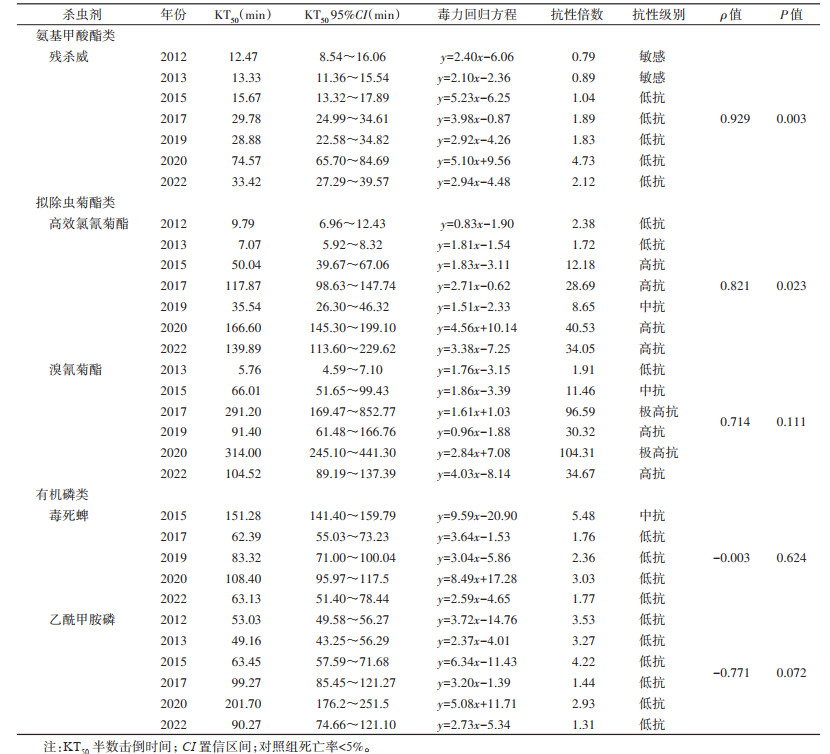扩展功能
文章信息
- 张艳, 宋丙栋, 孙燕群, 闵玥, 陈学敏, 李碧涵, 孙楠, 孙璐瑶, 张守刚
- ZHANG Yan, SONG Bing-dong, SUN Yan-qun, MIN Yue, CHEN Xue-min, LI Bi-han, SUN Nan, SUN Lu-yao, ZHANG Shou-gang
- 南京市2012-2022年德国小蠊密度和侵害率与抗药性变化分析
- Changes in the population density, infestation rate, and insecticide resistance of Blattella germanica in Nanjing, China, 2012-2022
- 中国媒介生物学及控制杂志, 2024, 35(3): 308-311, 342
- Chin J Vector Biol & Control, 2024, 35(3): 308-311, 342
- 10.11853/j.issn.1003.8280.2024.03.009
-
文章历史
- 收稿日期: 2023-12-22
2 南京医科大学公共卫生学院, 江苏 南京 211166
2 School of Public Health, Nanjing Medical University, Nanjing, Jiangsu 211166, China
德国小蠊(Blattella germanica)是南京市蜚蠊绝对优势种,作为一种危害严重的公共卫生害虫,其分布范围广且极难控制,主要通过机械性传播多种致病微生物和寄生虫,如伤寒沙门菌(Salmonella typhi)、链球菌(Strepto coccus)、金黄色葡萄球菌(Staphylococcus aureus)、大肠埃希菌(Escherichia coli)等[1-2];同时,其分泌物、蜕皮中的颗粒和尸体会引发人类严重的过敏性疾病、哮喘、皮炎等[3]。目前化学杀虫剂仍然是控制蜚蠊的主要手段,然而过度使用杀虫剂对人类和环境产生了不利影响,同时导致蜚蠊在全球范围内迅速产生了抗药性[4],对有机氯、有机磷、氨基甲酸酯和拟除虫菊酯类杀虫剂均产生不同程度抗性[5]。因此,监测德国小蠊历年密度和抗药性变化趋势对于合理使用杀虫剂和科学预防抗药性发展至关重要。本研究通过调查2012-2022年间德国小蠊密度和侵害率及其对常见5种杀虫剂抗药性水平,分析德国小蠊种群变化与抗药性水平发展趋势,为南京市科学防控德国小蠊及其抗药性发展提供理论指导。
1 材料方法 1.1 生态学监测按照《江苏省病媒生物监测方案》要求,2012-2022年间每年单月对南京市12个区使用粘捕法进行蜚蠊生态学监测,鉴别蜚蠊种类并计算密度、侵害率等数据。
1.2 抗药性监测 1.2.1 试虫按照《江苏省病媒生物监测方案》要求,进行抗药性监测,其中敏感种群约200只,由江苏省疾病预防控制中心(疾控中心)提供,野生种群由南京市12个区采用瓶捕法获得,每个区采集30~40只,总数量约600只(不含卵荚)。采集生境:农贸市场、餐饮店、糕点房,所有采集区域和生境每年固定不变。采集对象:德国小蠊成若虫和卵荚,实验室内饲养1代取羽化后2~3周龄雄性成虫约300只作为试虫。饲养条件:温度(25±1) ℃,相对湿度50%~80%,光周期(L∶D)=12 h∶12 h。
1.2.2 药剂与器材高效氯氰菊酯(92.00%)、溴氰菊酯(95.95%)、毒死蜱(97.00%)、残杀威(95.56%)、乙酰甲胺磷(96.30%)由江苏省疾控中心提供。
1.2.3 方法采用药膜法。实验组用丙酮将原药配制成1.0%的母液,再用丙酮稀释至0.05%,取2.5 ml置于500 ml广口瓶内,滚动瓶身使药液均匀涂壁,待丙酮挥发后24 h内测试。广口瓶瓶口处涂抹凡士林和石蜡油,防止试虫逃逸。对照组用2.5 ml丙酮,操作同上。每次将10只试虫放入瓶中,在不同时间间隔观察其击倒情况,直至2 h,试验重复3次,敏感品系以同样方法测定。虫体仰翻、六足抽搐、不能爬行视为击倒[6-7]。
1.2.4 评价标准抗性倍数(R/S)≤1为敏感;1 < R/S≤5为低度抗性;5 < R/S≤10为中度抗性,10 < R/S≤50为高度抗性;R/S > 50为极高度抗性[8]。
1.3 统计学分析采用SPSS 22.0软件中的Probit模块对数据进行处理,计算毒力回归方程、半数击倒时间(KT50)及其95%置信区间(confidence interval,CI)、抗性倍数等;Spearman等级相关对年份与密度、侵害率和抗药性水平进行相关性分析,P < 0.05为差异有统计学意义。
2 结果 2.1 蜚蠊密度和侵害率2012-2022年南京市蜚蠊密度分别为1.01、1.62、2.17、1.36、1.21、0.77、0.58、0.39、0.39、0.29和0.24只/张;侵害率分别为20.79%、28.80%、32.45%、28.89%、17.31%、10.92%、6.73%、5.64%、4.67%、5.00%和3.36%。2012年开始蜚蠊密度和侵害率均呈快速上升趋势,2014年达最高峰,分别为2.17只/张和32.45%,2015年开始呈快速下降趋势至较低水平,密度与侵害率变化趋势均有统计学意义(ρ=-0.897,P < 0.001;ρ=-0.909,P < 0.001)。见图 1。

|
| 图 1 2012-2022年南京市蜚蠊密度和侵害率变化趋势 Figure 1 Changes in cockroach density and infestation rate in Nanjing, 2012-2022 |
| |
2012-2022年,随年份增加德国小蠊对残杀威和高效氯氰菊酯抗性倍数总体上均升高,年份与抗性倍数呈显著的正相关(ρ=0.929,P=0.003;ρ=0.821,P=0.023)。2015年之前残杀威抗性级别为敏感,2015年上升为低度抗性,2020年抗性倍数达最高,为4.73。2015年之前高效氯氰菊酯抗性级别为低度抗性,2015年开始上升为中、高度抗性,2020年抗性倍数达最高,为40.53。2012-2022年,随年份增加,溴氰菊酯、毒死蜱和乙酰甲胺磷抗性倍数与年份相关性均不明显(ρ=0.714,P=0.111;ρ=-0.003,P=0.624;ρ=-0.771,P=0.072)。溴氰菊酯2013年抗性级别为低度抗性,2015年开始上升为中度、高度抗性,甚至极高度抗性,2020年抗性倍数达到最高,为104.31。毒死蜱抗性级别2015年为中度抗性,2015年后为低度抗性。乙酰甲胺磷2012-2022年保持为低度抗性。见表 1。

|
蜚蠊密度和侵害率是德国小蠊治理过程中衡量环境卫生的重要指标,也是检验治理水平的重要方式。本次研究发现,2015年开始南京市蜚蠊密度和侵害率均快速下降,且维持在较低水平,说明南京市在治理德国小蠊问题上取得显著成效。
本研究发现南京市德国小蠊对残杀威、高效氯氰菊酯、溴氰菊酯、毒死蜱和乙酰甲胺磷5种常用杀虫剂均产生不同程度的抗性,从2015年开始,德国小蠊对残杀威、高效氯氰菊酯和溴氰菊酯抗药性均增强。主要原因是目前国内外蜚蠊治理仍以化学治理为主[5],特别是近10年南京市创建国家卫生城市过程中频繁喷洒药剂导致德国小蠊抗药性水平持续增高[9]。这直接导致了目前化学防治方法难以控制蜚蠊密度[10-11]。持续使用杀虫剂过程中,杀虫剂用量、频率和蜚蠊平均存活时间是影响德国小蠊对杀虫剂产生抗性的主要原因,因此,从长远看,抗药性的持续增高可能会导致蜚蠊密度和侵害率呈现快速反弹,致使病媒防制工作失败。
既往研究显示南京市德国小蠊对拟除虫菊酯类以及有机磷类杀虫剂均表现出交互抗性[9, 12]。本研究中其对拟除虫菊酯类杀虫剂抗性水平较高,基本上达中度以上;对残杀威和有机磷类杀虫剂均达到低度抗性,与广东和浙江省调查结果基本一致[13-14]。
南京市德国小蠊对残杀威抗性级别自2015年开始由敏感转变为低度抗性,这一变化可能与南京市长期不当使用残杀威有直接关系。一般情况下,蜚蠊对有机氯、有机磷和拟除虫菊酯类杀虫剂均产生抗性时,残杀威是为数不多的有效可替代方法[15]。而近年来调查结果显示,国内外多数城市德国小蠊已对残杀威产生低抗[9, 11-14],因此,必须采取有效措施控制抗药性进一步发展。
目前防制蜚蠊抗性问题,首先应坚持环境整治为主,物理、化学治理为辅的总方针政策,即按照有害生物综合防治(integrated pest management,IPM)策略,开展知识宣教,环境卫生治理,使用粘蜚蠊板、胶饵等虫害控制措施,尽量减少使用化学喷雾方法[5]。其次,关于交互抗性问题,须通过市场监管局和卫生健康委等部门掌握全市杀虫剂销售流通情况和产品种类,通过疾病预防控制机构和病媒生物防制公司对家庭、超市、机关单位、农贸市场等场所杀虫剂具体使用情况进行摸排,评估近几年南京市各消杀场所用药史,逐步停用拟除虫菊酯类杀虫剂,并减少使用有机磷类杀虫剂,同时避免溴氰菊酯和高效氯氰菊酯以及毒死蜱和乙酰甲胺磷进行反复轮用或复配,进而降低由此引发的低成本效益[16]。选择低度抗性杀虫剂轮换用药,可将残杀威与毒死蜱或与乙酰甲胺磷等其他低度抗性或敏感药物轮换使用,争取在使用最少药物剂量下,杀灭率达到最高化,以期降低残杀威的抗药性。最后,研究喷洒用药对胶饵的影响。越来越多研究发现德国小蠊对胶饵中杀虫剂成分产生抗药性或至少耐受,单一或多重抗药性的德国小蠊对未使用过的毒饵亦能产生抗药性,可能原因是常见杀虫剂的喷洒而引起交互抗性[5, 17-18]。胶饵是继杀虫剂喷洒之后最重要的化学灭蜚蠊方法,未来如何预防和延缓杀虫剂喷洒引起的德国小蠊对胶饵抗药性问题将是抗药性研究的重点领域。在实际工作中,必须采取综合防治措施和科学合理用药保持德国小蠊对常用杀虫剂和胶饵的敏感性,以期长期有效控制其种群数量发展。
利益冲突 无
| [1] |
Pietri JE, Tiffany C, Liang DS. Disruption of the microbiota affects physiological and evolutionary aspects of insecticide resistance in the German cockroach, an important urban pest[J]. PLoS One, 2018, 13(12): e0207985. DOI:10.1371/journal.pone.0207985 |
| [2] |
Chehelgerdi M, Ranjbar R. Virulence factors and antibiotic resistance properties of Streptococcus species isolated from hospital cockroaches[J]. 3 Biotech, 2021, 11(7): 321. DOI:10.1007/s13205-021-02874-w |
| [3] |
Fazeli-Dinan M, Habibi A, Haghi SFM, et al. Determination of susceptibility levels of three different cockroach species including hospitals German cockroach, Blattella germanica L. (Blattodea: Blattellidae), to common insecticides, cypermethrin, propoxur and fenitrothion[J]. Int J Health Sci (Qassim), 2022, 16(4): 13-21. |
| [4] |
Cai T, Wang XJ, Liu BR, et al. A cuticular protein, BgCPLCP1, contributes to insecticide resistance by thickening the cockroach endocuticle[J]. Int J Biol Macromol, 2024, 254: 127642. DOI:10.1016/j.ijbiomac.2023.127642 |
| [5] |
Gondhalekar AD, Appel AG, Thomas GM, et al. A review of alternative management tactics employed for the control of various cockroach species (Order: Blattodea) in the USA[J]. Insects, 2021, 12(6): 550. DOI:10.3390/insects12060550 |
| [6] |
中国疾病预防控制中心. 全国病媒生物监测实施方案[Z]. 北京: 中国疾病预防控制中心, 2016. Chinese Center for Disease Control and Prevention. National vector surveillance implementation program [Z]. Beijing: Chinese Center for Disease Control and Prevention, 2016. (in Chinese) |
| [7] |
中华人民共和国国家质量监督检验检疫总局, 中国国家标准化管理委员会. GB/T 26352-2010蜚蠊抗药性检测方法德国小蠊生物测定法[S]. 北京: 中国标准出版社, 2011. General Administration of Quality Supervision, Inspection and Quarantine of the People's Republic of China, Standardization Administration of the People's Republic of China. GB/T 26352-2010 Test methods of cockroach resistance to insecticides-The bioassay methods for Blattella germanica[S]. Beijing: Standards Press of China, 2011. (in Chinese) |
| [8] |
Lee LC, Lee CY. Insecticide resistance profiles and possible underlying mechanisms in German cockroaches, Blattella germanica (Linnaeus) (Dictyoptera: Blattellidae) from Peninsular Malaysia[J]. Med Entomol Zool, 2004, 55(2): 77-93. DOI:10.7601/mez.55.77_1 |
| [9] |
Ghaderi A, Baniardalani M, Basseri HR. Level of pyrethroid-resistance associated with cytochrome P450 expression in German cockroach Blattella germanica (Blattodea: Ectobiidae) in the field collected strains[J]. J Arthropod Borne Dis, 2021, 15(2): 152-161. DOI:10.18502/jad.v15i2.7484 |
| [10] |
Wu XY, Appel AG. Insecticide resistance of several field-collected German cockroach (Dictyoptera: Blattellidae) strains[J]. J Econ Entomol, 2017, 110(3): 1203-1209. DOI:10.1093/jee/tox072 |
| [11] |
Hu IH, Chen SM, Lee CY, et al. Insecticide resistance, and its effects on bait performance in field-collected German cockroaches (Blattodea: Ectobiidae) from Taiwan[J]. J Econ Entomol, 2020, 113(3): 1389-1398. DOI:10.1093/jee/toaa053 |
| [12] |
王学军, 赖世宏, 刘峰. 德国小蠊抗性品系对化学杀虫剂交互抗性的研究[J]. 中国媒介生物学及控制杂志, 2004, 15(3): 178-179. Wang XJ, Lai SH, Liu F. Cross-resistance of cypermethrin-resistant Blattella germanica to chemical insecticides[J]. Chin J Vector Biol Control, 2004, 15(3): 178-179. DOI:10.3969/j.issn.1003-4692.2004.03.006 |
| [13] |
胡静, 刘阳, 张韶华, 等. 广东省深圳市德国小蠊对常用杀虫剂的抗药性分析[J]. 中国媒介生物学及控制杂志, 2021, 32(1): 70-73, 77. Hu J, Liu Y, Zhang SH, et al. An analysis of resistance of Blattella germanica to commonly used insecticides in Shenzhen, China[J]. Chin J Vector Biol Control, 2021, 32(1): 70-73, 77. DOI:10.11853/j.issn.1003.8280.2021.01.014 |
| [14] |
李天奇, 吴瑜燕, 刘钦梅, 等. 浙江省2018年德国小蠊抗药性监测结果分析[J]. 中国媒介生物学及控制杂志, 2022, 33(4): 462-465. Li TQ, Wu YY, Liu QM, et al. Surveillance results of the insecticide resistance of Blattella germanica in Zhejiang Province of China, 2018[J]. Chin J Vector Biol Control, 2022, 33(4): 462-465. DOI:10.11853/j.issn.1003.8280.2022.04.003 |
| [15] |
Kovacic P, Somanathan R. Propoxur: A novel mechanism for insecticidal action and toxicity[J]. Rev Environ Contam Toxicol, 2012, 218: 141-150. DOI:10.1007/978-1-4614-3137-4_4 |
| [16] |
侯银续, 王斐, 安洲, 等. 安徽省芜湖市2022年德国小蠊对常用卫生杀虫剂的抗药性调查[J]. 中国媒介生物学及控制杂志, 2023, 34(5): 612-616. Hou YX, Wang F, An Z, et al. Resistance of Blattella germanica to commonly used insecticides in Wuhu, Anhui Province, China, 2022[J]. Chin J Vector Biol Control, 2023, 34(5): 612-616. DOI:10.11853/j.issn.1003.8280.2023.05.005 |
| [17] |
Hu IH, Tzeng HY, Chen ME, et al. Association of CYP4G19 expression with gel bait performance in pyrethroid-resistant German cockroaches (Blattodea: Ectobiidae) from Taiwan[J]. J Econ Entomol, 2021, 114(4): 1764-1770. DOI:10.1093/jee/toab104 |
| [18] |
Lee SH, Choe DH, Rust MK, et al. Reduced susceptibility towards commercial bait insecticides in field German cockroach (Blattodea: Ectobiidae) populations from California[J]. J Econ Entomol, 2022, 115(1): 259-265. DOI:10.1093/jee/toab244 |
 2024, Vol. 35
2024, Vol. 35


